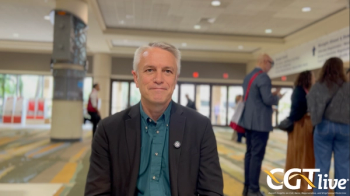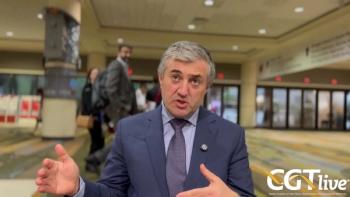
Collaboration Needed to Accelerate the Development of Cell Therapies for Spinal Cord Injury
Brian Culley, MS, the chief executive officer of Lineage Cell Therapeutics, discussed advancements made with SCI cell therapy OPC1 at the first Annual SCI Investor Symposium.
Spinal cord injuries (SCIs) remain an important area of unmet need, with many companies and organizations investigating new treatments, including cell therapies, to provide new options for patients with SCIs. The first Annual SCI Investor Symposium was held this year on June 29, in San Diego, California, with the intention of facilitating discussion and cooperation between various experts in the field, with the ultimate goal of accelerating the development of novel drugs and therapeutics. The symposium was launched by a collaborative effort including Lineage Cell Therapeutics and the Christopher & Dana Reeve Foundation.
On the day of the symposium, CGTLive™ spoke with Brian Culley, MS, the chief executive officer of Lineage Cell Therapeutics, about the goals of the meeting and the information he would be presenting there. Culley noted that during the development of OPC1, Lineage’s investigational cell therapy product consisting of oligodendrocyte progenitor cells (OPCs) being evaluated for the treatment of patients with SCIs in a phase 1/2a clinical trial (NCT02302157), the company has made important improvements in manufacturing and delivery methods; these findings were shared at the symposium.
CGTLive: What’s the importance of the first Annual SCI Investor Symposium?
Brian Culley, MS: The SCI Investor Symposium is an opportunity for companies that ostensibly would be competing to actually come together and align in areas of common pain. There are certain areas in the development of new therapeutics for SCI which represent gaps—there are a lot of questions about the kinds of end points and assessments we collect, a changing demographic for the patient population—and so we created this event so that folks could work together in a collaborative way, in academia and industry, to talk about areas where they can increase the probability of success. Specifically for Lineage Cell Therapeutics, we utilize a transplant of OPCs directly to the spinal cord in an effort to try to help individuals regain greater mobility through the recovery phase after their injury.
Can you give an overview of what you are presenting at the symposium?
The information that we are presenting is about OPC1, which is our lead program for SCIs. This is a program that has been tested to date in 30 individuals, 5 with thoracic injuries and 25 with cervical injuries. It had very evocative phase 1 data; we're very excited that it appears to show clinical signals. It was quite a safe and well tolerated therapy and we've got long-term follow up on those patients. There were [also] some improvements that we really thought would be important—improvements around how the cells are manufactured, even simple things like the scale to make them commercially viable, and also how the cells are delivered. We're working on a simpler way to deliver the cells to the spinal cord. We're going to talk about the journey of this program from its early days, through a couple of different sponsors, and then into our hands at Lineage and what we're doing to advance it to the next stage. Ultimately, our destination is a larger controlled study to answer the question: how much benefit does a patient get from receiving oligodendrocyte cells to the spinal cord after their injury?
What should the healthcare community take away from these findings?
The biggest problem is, as we see it, with SCI is the loss of flexibility, mobility, sensation, and the diminishment of quality of life. There is a natural recovery in many cases; people after an injury can regain some of their mobility—but everyone always wants more. Being able to treat individuals to help them increase their range of mobility is really important because even a small change, for example, in the rotation of the wrist muscles could provide the ability to manipulate a wheelchair and reposition a wheelchair without assistance. There's also an economic component: people who suffer from SCIs can have massive, massive costs of care and reducing those costs of care, while developing independence for the individual, is really great for the system, as well. So we're looking at how we can reduce the burden on the healthcare system, while also increasing the quality of life for the individuals and help them gain greater mobility and independence.
What challenges have you encountered so far with this research?
I think a couple of the biggest challenges in the setting of SCI are that—thankfully—it is a rare condition so to the extent that testing may require large numbers of individuals in order to see if a therapy is beneficial or not—that's not a solution because we have a very small number of individuals. If you have a therapy like ours, which is typically administered between week 3 and week 6 after an injury, if someone wasn't aware of the clinical trial and didn't have an opportunity to participate, once they get out to several months, they're probably not eligible anymore. So, one of the challenges is that this is an orphan condition—it's a relatively rare—again, thankfully—problem. The other problem is heterogeneity: you can have 2 very similar injuries that lead to vastly diverse outcomes for patients. One person might have considerable recovery and another might have very limited or in some cases even no recovery. Those are noises in the system that can be very difficult. To date, there have been no successful therapies—there have been no FDA-approved therapies. There have been a lot of attempts: there's electrostimulation, there's brain interfaces, there's biologics, small molecules, antibodies—many, many efforts. It's a challenging area, but I also think that represents a wonderful opportunity to havea big impact in this space.
Is there anything else you’d like to share with our audience?
I think something that is really important is for all of the companies, researchers, and academics to always keep in mind what is important to the patient. I think 1 of the challenges in a lot of different conditions can be that what matters to the patient might not be what the companies are working on. You really have to keep aligned with what's important to the patient—measure what's important to the patient—and then use that as your mission. Let them be the lead. If your therapeutic is solving a problem that they don't have—I’m not sure why you're doing that. We really have to always have good continuity among the regulatory bodies, the patients, their caregivers, the physicians, and then of course, the companies that are working on those new therapies.
Transcript edited for clarity.
REFERENCE
Lineage and the Christopher & Dana Reeve Foundation proudly present the 1st Annual Spinal Cord Injury Investor Symposium. News release. Lineage Cell Therapeutics, Inc. March 30, 2023. Accessed June 30, 2023. https://ir.teknova.com/news-releases/news-release-details/teknova-launches-proprietary-aav-tektm-solutions-gene-therapy
Newsletter
Stay at the forefront of cutting-edge science with CGT—your direct line to expert insights, breakthrough data, and real-time coverage of the latest advancements in cell and gene therapy.





































